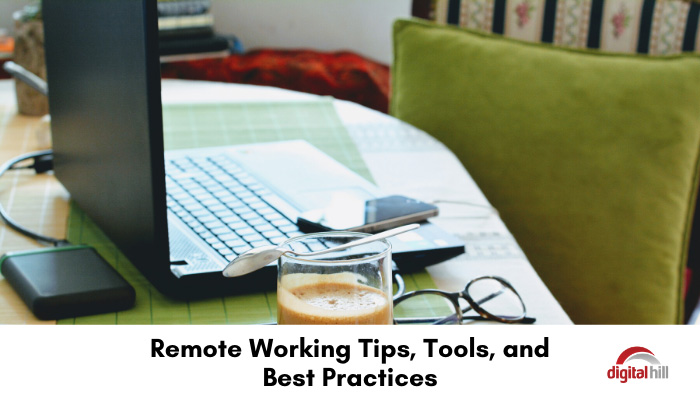Remote Working Tips, Tools, and Best Practices

UPDATE 3/16/2020 – Communication of any business related changes such as hours or access is important in these fast changing times! Use Email, Social Media, and your Website to get the word out and inform people. Your website can be your best resource for updates. Add a “Notice Bar” and link to a page with information. Contact us for information. Our Coronavirus business information page is here.
More and more companies are implementing a remote working policy due to coronavirus. Since our team has been doing remote work for a number of years already, I thought it might be helpful to share some remote working tips, tools, and best practices to help others just getting started. If you’re new to this setup or exploring remote career options, there are many great platforms to find work from home jobs that suit different skills and schedules.
First, and foremost, remote workers need to create a space for themselves and designate their time as “at work”. This is often important particularly if team members are working from home because there can be the potential distractions of daily life including dishes, family members at home, or even pets. These are normal and natural things, and team members need to set boundaries in order to focus. It can be OK to work at the dining room table if the proper mindset and boundaries are in place, but sometimes it can be helpful to have another designated “workspace” such as a desk or home office to use. First, and foremost, remote workers need to create a space for themselves and designate their time as “at work”. This is often important particularly if team members are working from home because there can be the potential distractions of daily life including dishes, family members at home, or even pets. There are many remote 4 day work week jobs available that emphasize the importance of maintaining a focused work environment. These are normal and natural things, and team members need to set boundaries in order to focus. It can be OK to work at the dining room table if the proper mindset and boundaries are in place, but sometimes it can be helpful to have another designated “workspace” such as a desk or home office to use.
Another tip is the importance of regular communication. Some set “check-in” meetings are helpful to keep people feeling connected, “in the know”, and on task with the team goals.
Let’s dive into the remote working tools we use next.
Remote Working Tools:
Next, come the tools. Simple things like high-speed internet, a laptop or computer, access to files in the Cloud, and more are necessary. Here are some of our go-to tools.
- Zoom – Call and video conference software with screen sharing for online client meetings.
- Google Drive – File sharing, document writing, collaborative spreadsheets and more.
- Email – This may seem like common sense but it plays a vital role in communication. Use email and communicate often and well!
- Asana – Project management system to keep all team members informed, assigned work, and up-to-date on status, tasks assigned, and responsibilities.
- Google Hangouts – Key tool for quick daily communication via chat. We use Google Hangouts for team online chats, 1-to-1 chat, as well as for use in short video conference meetings internally.
We also use our internal CRM system, proposal system, and project task time tracker to keep track of prospects, client data, proposals in the pipeline and the time invested in current sold projects. For phone calls, we have a VOIP system with Vonage which offers phone apps and a desktop app so that we can answer calls from the office and make calls from the office lines on our mobile phone or computer.
Remote Working Best Practices:
- Over-communicate – People can feel isolated in remote spaces, so regular meetings are important. We have video team meetings with each team member a minimum of 1x per week to touch base, cover their current work, and set direction together.
- Consider your workspace – Standing, desk, dining room table. There is flexibility. You need to find what works to enable you to get in the “work zone.”
- Figure out your working style – As a company, are there expectations on when you work and when you are available? We have a “core 10 to 2” work policy where team members must be available for meetings and to respond during those hours (ET) and beyond that, they have the flexibility of when they put in their hours. Most work roughly 8-5 but it gives freedom to shift that around.
That’s a starting place on remote working. Have questions on how we do it? Let us know! One additional resource for you on leading remote teams is my podcast episode on the 3 T’s for leading remote teams well.
